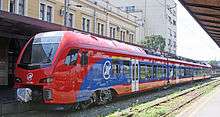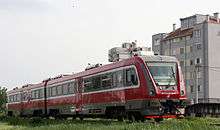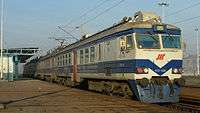Serbian Railways
Native name | Железнице Србије / Železnice Srbije |
|---|---|
| Government owned | |
| Industry | Rail transport |
| Founded |
Belgrade, Serbia (May 17, 2005) First founded 1881 |
| Headquarters | Belgrade, Serbia |
Area served | Serbia |
Key people | Vacant (General director) |
| Products | Rail transport, Cargo transport, Services |
| Revenue |
|
|
| |
| Total assets |
|
| Total equity |
|
| Owner | Government of Serbia (100%) |
Number of employees | 19,896[1] |
| Website |
www |
| Locale | Serbia |
|---|---|
| Dates of operation | 1881–present |
| Track gauge | 1,435 mm (4 ft 8 1⁄2 in) |
| Length | 3,809 kilometres (2,367 mi)[2] |
Serbian Railways (Serbian: Железнице Србије / Železnice Srbije) is the national railway company of Serbia. Serbian Railways is a member of the International Union of Railways (UIC). The UIC Country Code for Serbia is 72.
History

The history of rail transport in Serbia began in the mid-19th century when most of the territory was still held by the Austro-Hungarian and Ottoman Empires. The first rail line on the present-day territory of Serbia was inaugurated on 20 August 1854, between Lisava-Oravica-Bazijaš and the train operated on horse-drawn traffic which were replaced in 1856 by steam locomotives. Part of the line is located in Serbia passing through Bela Crkva while the rest is in Romania. All subsequently built lines were laid towards Budapest as the territory was still part of the Austro-Hungarian Empire back then. On the territory which was under the Otomans, the line Skopje-Kosovska Mitrovica was inaugurated in 1874. However, the major expansion began after the Berlin Congress and the independence of the, theretofore vassal to the Ottomans, Kingdom of Serbia during the second half of the 19th century.[3]
Serbian Railways as a company is traced back to 1881 when King Milan I declared formation of the Serbian National Railways. The first train departed from Belgrade to Niš on 23 August 1884, which is considered by Serbian Railways as the official year when the company was created.
This was not the first operational railway on the territory of then-Kingdom of Serbia, though, as the one in opened in 1882, a primarily industrial, though occasionally used for passenger transport, 12 km long 600 mm wide gauge track from Majdanpek copper processing plant to Velike Livade and constructed by the „Serbian Copper & Iron Co" (official name in English, most stock holders were British) had its first run on the track in June 1882.[4]
Another one in Eastern Serbia followed suit in 1888, the 82 km long dual purpose (industrial and passenger transport) 760 mm gauge track from Vrška Čuka mine to the port of Radujevac on the Danube, built by the Societé Anonyme "L'Industrielle Serbe" registered at Brussels in Belgian, French, (Austro-)Hungarian, and Serbian ownership (in order of the percentage of stock owned).,[5][6]
From the 1920s to the dissolution of Yugoslavia it operated under the name Yugoslav Railways. The first electrified line was opened between Belgrade and Šid in 1970.
The Blue Train which was a luxorious train specially built and used by the former Yugoslav President Josip Broz Tito,[7] is still put in service for the Serbian Railways on special occasions.[8]
Modernisation
In 2010, Serbian Railways joined Cargo 10, a joint venture with other railways in the region.[9] The European Bank for Reconstruction and Development has given a series of four loans to support modernisation.[10]
After decades of neglect, new investments took place since 2010. Twelve new trains from the Metrovagonmash were ordered and are in service, with additional 35 on order. Because of this, there are preliminary reports that the passenger ridership has skyrocketed on the services operated by the new trains.
Moreover, on the 4th of March 2013, Serbian railways signed a contract with Swiss company Stadler Bussnang on the acquisition of 21 new passenger trains (Stadler FLIRT). The first train was delivered in late September 2014, while the last arrived in August 2015. The new trains will mostly serve regional traffic.[11] Railroad tracks are also under reconstruction, and new tracks are being built. Under new management, the Serbian railways were able to cut operating costs by 2.8 billion Serbian dinars for Q1 2013. Previously, the newly appointed CEO referred to the overall situation in Serbian railways as "disastrous".
In July 2013, Serbian Railways signed a modernisation agreement with RZD International, funded by the Russian government, worth US$800M. This will focus on improving key sections of railway, doubling tracks, and the purchase of several Russian-built DMUs.[12]
2014 floods
Several railways in Serbia as well as in neighboring countries line were submerged or damaged during the 2014 Balkan floods. Beovoz suspended its Belgrade-Valjevo service, and multiple sections of the Belgrade-Bar line were damaged. A rail bridge in Kolubara was swept away in the floods. In June 2014, work on sanitizing rail infrastructure and recovering flooded sections began.[13] The Belgrade-Bar railway went into operation in March 2015, and the section through Serbia is expected to be overhauled with funds from the Russian credit.
Rolling stock


The rolling stock consists mostly of fast electric train sets (EMU class 412) and of electric locomotives built in the cooperation between Mašinska Industrija Niš (MIN) and KONČAR Group (classes 441 and 444), under the Swedish licence, as well as Romanian built Electroputere Craiova (classes 461 which is used mainly for cargo transport due to its moderate speed), built under the same licence. Some of these locomotives recently underwent comprehensive modernization either by MIN or Končar Zagreb. In March 2013 an order was put for 21 FLIRT3 EMUs for regional traffic, and the vehicles are expected to be delivered between 2014 and 2015.[14]
The diesel traction is powered by locomotives built by General Motors Company (classes 645, 661, 664, 666), MIN (classes 741, 742, 734), Macosa (class 644), Đuro Đaković Company (class 662, 643, 642), Metrovagonmash 711, as well as by some other, mostly European suppliers. Diesel trainsets (DMU classes 710, 712 and 812) are used mainly on local lines.
The Belgrade suburban railway system uses 16 RVR 412 trains built by Rīgas Vagonbūves Rūpnīca.
Metrovagonmash Class 711
On 14 April 2010, Serbian railways director Milovan Marković and manager of the Russian company Metrovagonmash signed a contract for the delivery of 12 new diesel motor train sets.[15] The first of the new diesel trains began commercial service from Belgrade to Vršac on 7 March 2012.[16] The acquirement of the Class 711 trains was regarded as historic by some Serbian media as it was the first time in over 30 years that a new train was purchased by a Serbian railroad operator.[17] The train (on Serbian tracks) travels up to 74 miles per hour (120 km/h).[18] The duration of the Belgrade-Vršac line with the new Class 711 trains was cut to just under 2 hours.[19][20] Some 27 more units are scheduled for arrival by the end of 2016. They are expected to take ageing railbuses out from the last few routes remaining.
Services
Serbian Railways offers many services which include local intra-city routes, domestic inter-city routes, and international routes.
The Avala inter-city train serves destinations like Venice, Munich, Vienna, Budapest and Moscow[21] and they all pass through Mala Krsna, the second biggest railroad knot in Serbia.
The direct service between Belgrade and Sarajevo, which was cut in the early 1990s during the Yugoslav Wars, was reopened in December 2009 and then canceled again in January 2013.[22]
Beovoz

The city of Belgrade has its own commuter rail transit system called Beovoz which is operated by Serbian Railways. Beovoz is a portmanteau of the Serbian words Beograd ("Belgrade" in Serbian) and voz ("Train" in Serbian).[23] While Beovoz is currently a comparable system to the Tehran Metro, the Belgrade Metro rapid subway system is scheduled to open in 2017 and therefore overlap and replace some Beovoz operations.[24] The Belgrade tram system, a similar system to many rapid transit systems around the world, is operated by GSP Beograd as opposed to Serbian Railways.[25]
Belgrade-Bar Line
The Belgrade-Bar line is a famous railway line that operates from Belgrade, Serbia, to Bar, Montenegro. A part of the line actually passes into Bosnia and Herzegovina at the Štrpci station.[26] It is an important railway as it possesses a large share in passenger travel between Belgrade and Podgorica which is heavily competed by air, bus, and automobile travel. The line is also operated by Railways of Montenegro.[27] As of 2011, the tracks on the Belgrade-Bar line are said to be alarmingly neglected as some sections of the track are so deteriorated that they prevent passing trains from traveling faster than 18 miles per hour.[28][29] As of March 2012 the duration of the Belgrade-Bar trip is slightly over 11 hours.[30]
The line is famous for being one of the most scenic long-distance railways in the world in part due to the Mala Rijeka Viaduct, which is not only the longest bridge on the Belgrade-Bar route,[31] but also the second tallest in the world; it stands 656 feet above the Mala Rijeka (Serbian: Little River).[32]
Balkan Express
The Balkans Express line is a railway line that operates from Belgrade, Serbia, to Istanbul in Turkey.[33] It goes through Bulgaria and serves many cities like Sofia, Plovdiv, and Dimitrovgrad in between before crossing the Turkish border.[34] The line is operated by Serbian Railways, Turkish State Railways, and Bulgarian State Railways.
ICS – Inter-City Serbia
The ICS is a service that offers domestic connections from Belgrade to Novi Sad, Subotica and Prijepolje stopping in each line to all the important local stations.[35]
Šargan Eight
.jpg)
The Šargan Eight is one of Serbia's domestic railroad line which operate in the Zlatibor district. It is a narrow gauge railway which is classified as a heritage railway. It operates passenger travel from Mokra Gora to Šargan Vitasi Station. Originally, the Šargan Eight connected Serbia with Bosnia and Herzegovina when it was first constructed in 1916; the original link extended all the way to Višegrad. Today, however, the train only uses 9.6 miles of track on its trips from Mokra Gora to Šargan.[36]
One of the Prophecies of Kremna supposedly envisioned by controversial peasant Mitar Tarabić predicted the construction of a railroad in southwestern Serbia several decades before it was first constructed during the First World War.[37]
Through the Gypsy's descent the iron road will pass with the fiery iron car that will always stop in locations where there are now Gypsy tents...many years will pass before people will again remember the iron road and they will renew it again.— Mitar Tarabic (1829-1899)[38]
Incidents and accidents
- On 27 February 1993, 18 Bosniaks and one Croat travelling on a Yugoslav Railways passenger train en route from Belgrade were abducted at the Štrpci rail station. They were subsequently taken by their captors to Višegrad where all 19 of them were executed.[39] The incident is known as the Štrpci massacre.
- On 12 April 1999, during the 1999 NATO bombing of Yugoslavia, a Yugoslav Railways passenger train was hit by a NATO cruise missile in Grdelica; a total of 14 people were killed.[40][41] (see: Grdelica train bombing)
Rail links with adjacent countries
Gallery
 EMU SR Class 412.
EMU SR Class 412.- EMU SR Class 412.

- File::ŽS 661 between Dimitrovgrad and Pirot.jpgSR Class 661 near Pirot.
 SR Class 666 near Ruma.
SR Class 666 near Ruma. SR Class 661 near Pirot.
SR Class 661 near Pirot. SR Class 710 near Niš.
SR Class 710 near Niš.
See also
References
- 1 2 3 4 5 Основни подаци из консолидованог финансијског извештаја за 2013. годину. Agencija za privredne registre Srbije (in Serbian). Retrieved 18 June 2014.
- ↑
- ↑ History at Serbian Railways official website
- ↑ Reference in Serbian
- ↑ Reference in Serbian
- ↑ Reference in Serbian with a French introduction and abstract
- ↑ http://www.zeleznicesrbije.com/active/en/home/glavna_navigacija/prezentacije/plavi_voz/node_1157030172.html Blue Train - History at Serbian railways official website
- ↑ Blue Train - Commercial offer at Serbian Railways official website
- ↑ "Balkan railways: From Berlin to Beijing?". The Economist. 2010-09-26. Retrieved 2010-09-26.
- ↑ "New EBRD funds to improve rail infrastructure in Serbia". Retrieved 2010-10-07.
- ↑ http://www.b92.net/eng/news/business.php?yyyy=2013&mm=03&dd=04&nav_id=84992
- ↑ "News in Brief". Railway Gazette International. Retrieved 1 November 2013.
- ↑ B92: Počela obnova pruge Beograd-Bar (Serbian) 27 May 2014
- ↑ "Stadler flirting in Serbia". Stadler Rail. 4 March 2013.
- ↑ , Serbian Railways: "Serbian Railways" and "Metrovagonmaš" from Russia signed the Contract about purchase of ten new diesel – motor trains .
- ↑ New train from Russia goes on Serbian tracks (Serbian)
- ↑ Tanjug - The new train from Russia from today on the Belgrade-Vrsac line (Serbian) - 7 March 2012
- ↑ Russian train on Serbian tracks - RTS - 6 March 2012
- ↑ Beta press-Ekonomija (Serbian) 6 March 2012
- ↑ Novosti - Jezdi "Ruski" voz (Serbian)
- ↑ http://www.uz.gov.ua/index.php?m=info.info_posagiriv.rozklad_ruhu&f=ScheduleOra.Train&T1=38408&lng=ru
- ↑ Belgrade-Sarajevo railway reopens after 17 years, BBC News, 13 December 2009.
- ↑ Google Translate
- ↑ http://www.24sata.rs/vesti/beograd/vest/prva-linija-metroa-2017-godine-od-ustanicke-do-tvornicke-ulice/15212.phtml
- ↑ GSP official website
- ↑
- ↑ Railways of Montenegro - Novosti (Serbian)
- ↑ Politika Vesti Dana - 1 February 2010 (Serbian)
- ↑ Serbian "fast rail" under 60 km/h (Serbian
- ↑ From today Belgrade-Bar daily train - B92 (Serbian) 21.3.2012
- ↑ Serbia Construction The Mala Rijeka bridge
- ↑ Mala Rijeka Viaduct at HighestBridges.Com Mala Rijeka Viaduct at HighestBridges.com
- ↑ B92-Travel-9 February 2012
- ↑ Turizam za vas i nas (Serbian) - 24 November 2011
- ↑ ICS Inter City Serbia at Serbian Railways official website
- ↑ Restoran Sarganska osmica (Serbian)
- ↑ Jat Airways Review June 2006
- ↑ New Jat Airways Review
- ↑ 19 years since abduction in Strpci - B92
- ↑ Serbian Railways News - 12 April 2007
- ↑ BBC News - Friday, 7 January 2000
External links
| Wikimedia Commons has media related to Železnice Srbije. |
- Official website
- Clip about the Belgrade railway hub and Beovoz commuter network
- Clip about the new central railway station
- Serbian Rail Map (passenger lines)